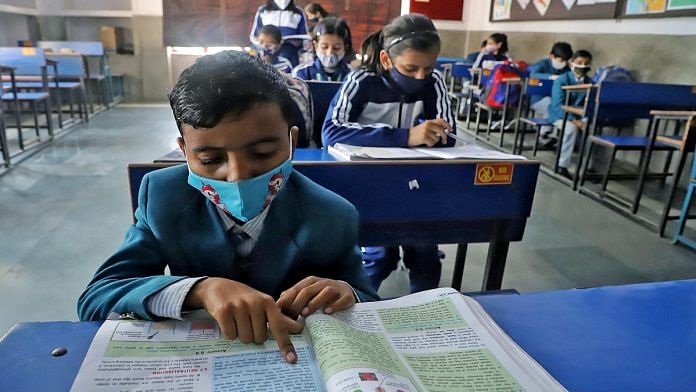New Delhi: Students of Class 3 and Class 5 in Delhi fared lower than the national average in three subjects — mathematics, language and environmental science (EVS) — according to the central government’s latest National Achievement Survey (NAS).
However, Delhi’s Class 8 and Class 10 students were found to perform better than the national average, with additional subjects forming the yardstick for these levels, the NAS found.
Findings of the nationwide survey — conducted last year — come in the backdrop of claims by the Aam Aadmi Party (AAP) that its government in Delhi has made great strides in improving Delhi’s public education system, a model it claims can be replicated across the country.
While majority of primary schools (Classes 1 to 5) in Delhi are managed by the Municipal Corporation of Delhi (MCD), the Delhi government provides education to students of Classes 1 to 12 in its Sarvodaya Vidyalaya schools.
The survey, conducted every three years with the objective of testing basic learning capabilities of children in order to guide educators about the need for intervention, also found that the learning capabilities of children declined as they progressed to higher classes.
The Ministry of Education said about 34 lakh students from 1.18 lakh government schools (central and state), government-aided schools and private-unaided schools across 720 districts (both rural and urban) participated in NAS 2021.
While students of Class 3 and Class 5 were tested for language, mathematics and EVS, students of Class 8 were tested for language, mathematics, science and social science, and students of Class 10 were tested for mathematics, science, social science, and English.
“The objective of NAS 2021 is to evaluate children’s progress and learning competencies as an indicator of the efficiency of the education system, so as to take appropriate steps for remedial actions at different levels,” a press release issued by the ministry read.
The nationwide survey was administered simultaneously by the Central Board of Secondary Education (CBSE) in a single day using an OMR-based test consisting of multiple-choice questions (MCQs).
Also Read: Fake ICSE to CBHE — over 100 unrecognised school boards are taking Indian students for a ride
Drop in mean score in higher classes
The national mean score for all levels (classes 3, 5, 8 and 10) and subjects was found to be lower than that of the previous National Achievement Survey conducted in 2017.
For instance, compared to 336 in 2017, the national mean score for language for Class 3 students last year was 326. Similarly, the mean score for mathematics for Class 3 students was 306 — down from 321 in 2017.
Another key takeaway of the NAS 2021 — learning capabilities of children were found to decline as they progressed to higher classes.
For example, when evaluated out of 500 marks in each subject, Class 3 students scored more than Class 8 or 10 students across all subjects — evident by the difference in the national mean score for mathematics for Class 3 students (306), Class 5 students (284), Class 8 students (255), and Class 10 students (220).
But state-wise and district-wise findings of the survey also suggest that students at all levels performed better than the national average in a number of states/UTs, including Punjab, Chandigarh, Rajasthan, and Kerala.
Conducted during the time of school closure, the survey also asked students if they faced any difficulty while studying from home.
Of those surveyed, 24 per cent said they did not have access to a device at home that they could use to study, 80 per cent said they would have learnt better at school, and 70 per cent said they had a lot of time to learn new things while at home.
(Edited by Amrtansh Arora)
(This story has been updated.)



